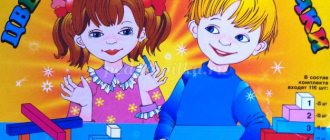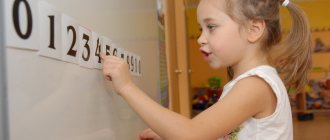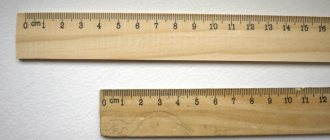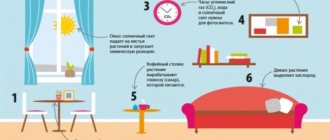Goal : Formation of elementary mathematical concepts in children of the older group using
Cuisenaire rods .
Tasks :
Educational:
1. Reinforce the concept that the stick (each color) has its own number.
2. Exercise your ability to work with diagrams using your imagination.
3. Teach children to make the number 6 from two smaller numbers;
4. Strengthen children’s understanding of size (length) and color.
6. Expand and consolidate children’s knowledge about fairy tales.
Educational:
1. Develop memory, logical thinking, imagination, attention, speech,
ability to reason and prove.
Educators:
1. Cultivate an interest in mathematics and the ability to work in a team.
Equipment:
Cuisenaire sticks for each child , diagram for building a car, cards with cribs for each child, presentation.
Treats for children. Methodical techniques:
Visual;
Verbal (reminders, instructions, questions);
Gaming (surprise moment);
Encouragement, differentiated analysis of the lesson.
What parents need to know about the method
Back in the mid-twentieth century, educators realized that teaching would be more effective if children were interested in learning. Such interest can be achieved using original techniques. This is how the creation of visual educational materials began, thanks to which a child, using mainly tactile sensations, can more easily absorb large amounts of information.
The gaming technology of “Cuisenaire sticks” uses a set of various bars. The color of each of them is associated with a specific numerical value. From the point of view of mathematical science, sticks-bars denote sets in which the values of order and equivalence (equivalence) are embedded. These blocks develop mathematical abilities, forming future interest in a school subject based on the child’s independent practical activity in a natural way for him, that is, in a playful way.
Understanding mathematics has long been inextricably linked with clarity; numbers necessarily signify the objects behind them. This technique is based on this principle, making it easier to learn the basics of counting. Color and shape are a kind of model of number, leading the child to understand the abstract concepts of elementary mathematics.
Important: teachers pay attention to the fact that the quantitative characteristics of a set, that is, the connection between color and number, are more difficult for children to learn. Awareness of this principle occurs thanks to the efforts of adults. Parents themselves need to master the technology.
Cuisenaire's technique: advantages
Cuisenaire's technique is universal; it does not conflict with any of the existing techniques, but, on the contrary, successfully complements them.
Cuisenaire sticks are simple and understandable to children: they get used to them at a very early age and already perceive them as playing material, and do not see them as boring memorization of numbers.
In addition to the obvious effectiveness of teaching the technique, Cuisenaire's rods also involve a number of border areas: they develop fine motor skills, visual and spatial perception, stimulate the imagination, and teach order.
The second stage of working with Cuisenaire rods: mathematical
The second stage of working with sticks is mathematical. Children literally learn to “feel” numbers, that is, learning takes place not through abstract concepts, which are still very vague for children, but through practice.
Cuisenaire sticks will help you master fractional numbers. For example, take a brown stick representing the number 4. How many red sticks fit into it and, accordingly, what part is the red stick from the brown one?
It's 2/4
How many green sticks fit into a brown stick and what part does the green stick make up of the whole? It's 3/4
It's 9/10
Cuisenaire rods are a simple “calling card” of the multiplication table. Let's start with a white stick representing the number one. If you take it in the singular, you get the number one. If you take ten white sticks, you get the number 10, which you need to check with the “right stick.”
Other examples of tasks at the second stage:
- Take several white sticks and move them close together in a row. Find an analogue in the set.
- You name the number and the child finds a stick of the corresponding color. At first, the numbers can be called in order, but then the task becomes more complicated, the numbers come apart.
- Take the shortest stick. What color is it? The white stick is a unit, the number “one”.
- For a colored stick, you need to match its analogue, shown on the card in the form of a number.
Cuisenaire rods and language learning
Cuisenaire rods are widely popular as teaching materials for teaching mathematics. But their role in language learning is also very great. Abroad, sticks are actively used in English lessons; they help highlight unstressed and stressed syllables and emphasize rhythms. This technology can be successfully applied in our native language, Russian.
This is how we show the stress and divide the syllables accordingly - a very popular technique for teaching reading, which you may have seen before in our alphabet books:
Cuisenaire rods provide a clear illustration for comparative adjectives.








